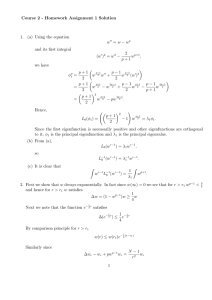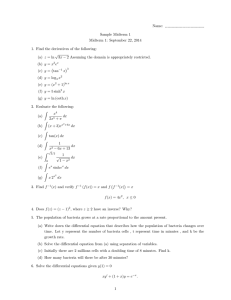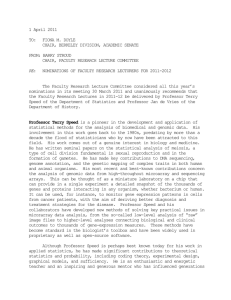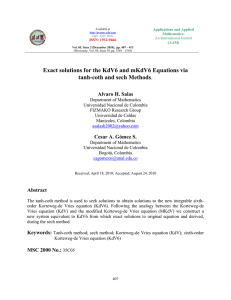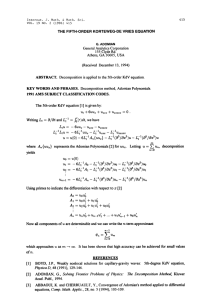The Korteweg-de Vries Equation: History, exact Solutions, and graphical Representation
advertisement
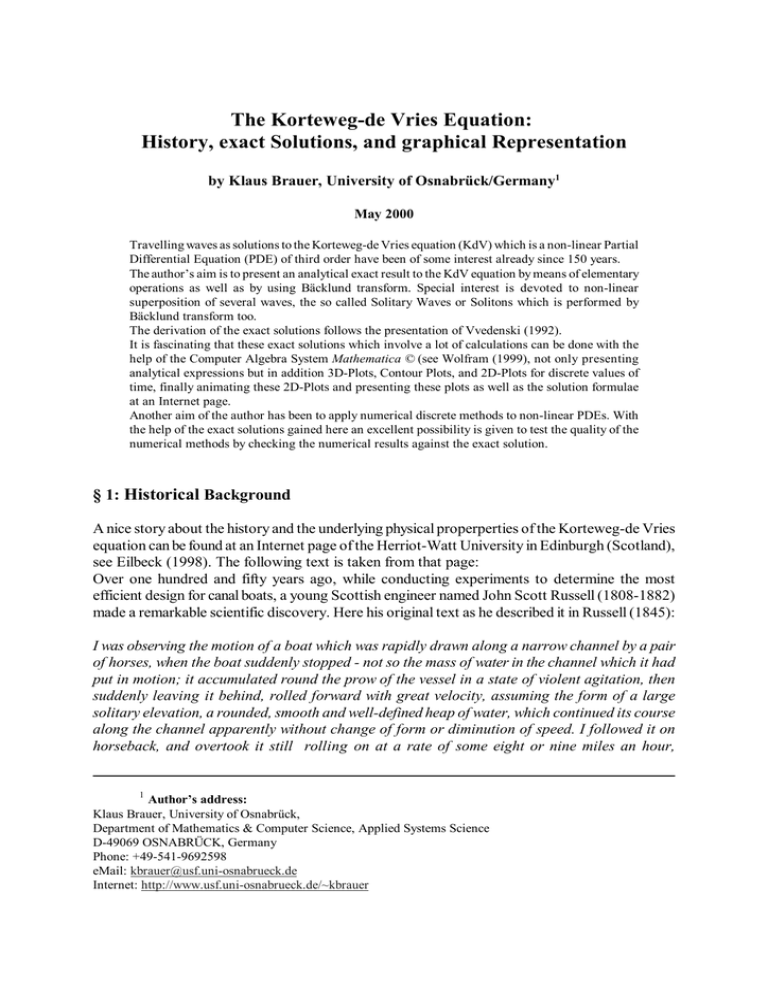
The Korteweg-de Vries Equation:
History, exact Solutions, and graphical Representation
by Klaus Brauer, University of Osnabrück/Germany1
May 2000
Travelling waves as solutions to the Korteweg-de Vries equation (KdV) which is a non-linear Partial
Differential Equation (PDE) of third order have been of some interest already since 150 years.
The author’s aim is to present an analytical exact result to the KdV equation by means of elementary
operations as well as by using Bäcklund transform. Special interest is devoted to non-linear
superposition of several waves, the so called Solitary Waves or Solitons which is performed by
Bäcklund transform too.
The derivation of the exact solutions follows the presentation of Vvedenski (1992).
It is fascinating that these exact solutions which involve a lot of calculations can be done with the
help of the Computer Algebra System Mathematica © (see Wolfram (1999), not only presenting
analytical expressions but in addition 3D-Plots, Contour Plots, and 2D-Plots for discrete values of
time, finally animating these 2D-Plots and presenting these plots as well as the solution formulae
at an Internet page.
Another aim of the author has been to apply numerical discrete methods to non-linear PDEs. With
the help of the exact solutions gained here an excellent possibility is given to test the quality of the
numerical methods by checking the numerical results against the exact solution.
§ 1: Historical Background
A nice story about the history and the underlying physical properperties of the Korteweg-de Vries
equation can be found at an Internet page of the Herriot-Watt University in Edinburgh (Scotland),
see Eilbeck (1998). The following text is taken from that page:
Over one hundred and fifty years ago, while conducting experiments to determine the most
efficient design for canal boats, a young Scottish engineer named John Scott Russell (1808-1882)
made a remarkable scientific discovery. Here his original text as he described it in Russell (1845):
I was observing the motion of a boat which was rapidly drawn along a narrow channel by a pair
of horses, when the boat suddenly stopped - not so the mass of water in the channel which it had
put in motion; it accumulated round the prow of the vessel in a state of violent agitation, then
suddenly leaving it behind, rolled forward with great velocity, assuming the form of a large
solitary elevation, a rounded, smooth and well-defined heap of water, which continued its course
along the channel apparently without change of form or diminution of speed. I followed it on
horseback, and overtook it still rolling on at a rate of some eight or nine miles an hour,
1
Author’s address:
Klaus Brauer, University of Osnabrück,
Department of Mathematics & Computer Science, Applied Systems Science
D-49069 OSNABRÜCK, Germany
Phone: +49-541-9692598
eMail: kbrauer@usf.uni-osnabrueck.de
Internet: http://www.usf.uni-osnabrueck.de/~kbrauer
Klaus Brauer: The Korteweg - de Vries Equation
2
preserving its original figure some thirty feet long and a foot to a foot and a half in height. Its
height gradually diminished, and after a chase of one or two miles I lost it in the windings of the
channel. Such, in the month of August 1834, was my first chance interview with that singular and
beautiful phenomenon which I have called the Wave of Translation.
This event took place on the Union Canal at Hermiston, very close to the Riccarton campus of
Heriot-Watt University, Edinburgh.
Throughout his life Russell remained convinced that his solitary wave (the ‘‘Wave of Translation’’)
was of fundamental importance, but ninteenth and early twentieth century scientists thought
otherwise. His fame has rested on other achievements. To mention some of his many and varied
activities, he developed the "wave line" system of hull construction which revolutionized ninteenth
century naval architecture, and was awarded the gold medal of the Royal Society of Edinburgh
in 1837. He began steam carriage service between Glasgow and Paisley in 1834, and made the
first experimental observation of the "Doppler shift" of sound frequency as a train passes. He
reorganized the Royal Society of Arts, founded the Institution of Naval Architects and in 1849
was elected Fellow of the Royal Society of London.
He designed (with Brunel) the "Great Eastern" and built it; he designed the Vienna Rotunda and
helped to design Britain’s first armoured warship (the "Warrior"). He developed a curriculum for
technical education in Britain, and it has recently become known that he attempted to negotiate
peace during the American Civil War.
It was not until the mid 1960’s when applied scientists began to use modern digital computers to
study nonlinear wave propagation that the soundness of Russell’s early ideas began to be
appreciated. He viewed the solitary wave as a self-sufficient dynamic entity, a "thing" displaying
many properties of a particle. From the modern perspective it is used as a constructive element
to formulate the complex dynamical behaviour of wave systems throughout science: from
hydrodynamics to nonlinear optics, from plasmas to shock waves, from tornados to the Great Red
Spot of Jupiter, from the elementary particles of matter to the elementary particles of thought.
For a more detailed and technical account of the solitary wave, see Bullough (1988).
The phenomenon described by Russell can be expressed by a non-linear Partial Differential
Equation of the third order. To remind: A partial differential equation (PDE) is a mathematical
equation which contains an unknown function of more than one variable as well as some
derivatives of that function with respect to the different independent variables. In practical
applications where the PDE describes a dynamic process one of the variables has the meaning of
the time (hence denoted by t) and the other (normally only up to 3) variable have the meaning of
the space (hence denoted by x, y and z)
We consider the simplest case in only one space variable x. So we are looking for a function u
depending on the variables x and t, i.e. u(x,t) which describes the elongation of the wave at the
place x at time t.
Using the typical short denotations as
ut ( x, t )
u ( x, t )
t ;
u ( x, t )
u ( x, t ) x ;
x
u xx ( x, t )
x
2
u ( x, t )
2
; uxxx ( x, t )
3
x
u( x, t )
3
Klaus Brauer: The Korteweg - de Vries Equation
3
the problem can be formulated as:
(1)
ut ( x, t )
6 u ( x, t ) ux ( x, t )
u xxx ( x, t )
0
This is the Korteweg-de Vries Equation (KdV) which is nonlinear because of the product shown
in the second summand and which is of third order because of the third derivative as highest in
the third summand. The factor 6 is just a scaling factor to make solutions easier to describe.
The aim here is to find general exact solutions to (1), i.e.: here we have neither initial conditions
nor boundary conditions. The solutions to (1) are called Solitons or Solitary waves.
The Korteweg-de Vries is a hyperbolic PDE in the general sense of the hyperbolicity definition.
From that it follows that it describes a reversible dynamical process.
The author’s interest for analytical solutions of (1) stems from the fact that in applying numerical
methods to non-linear PDEs, the KdV equation is well suited as a test object, since having an
analytical solution statements can be made on the quality of the numerical solution in comparing
the numerical result to the exact result.
The main part of the subsequent deduction of an analytical solution to (1) is taken from
Vvedenskii (1992), who has shown how to find an exact solution to the KdV equation and who
has used the tool of Bäcklund transform to obtain an analytical solution and who - in addition to
that - performs non-linear superposition of two, three and more solutions corresponding to two,
three or more soliton waves by using Bäcklund transform again.
§ 2: Exact Solution to the KdV Equation
We remember that the simplest mathematical wave is a function of the form u( x, t ) f ( x c t )
which e.g. is a solution to the simple PDE ut c ux 0 where c denotes the speed of the wave.
For the well known wave equation utt c 2 uxx 0 the famous d’Alembert solution leads to
two wave fronts represented by terms f ( x c t ) and f ( x c t ) .
Hence we start here with a trial solution
u( x, t )
(2)
z( x
t)
z( )
just denoting the parameter c above by here and the function f by z.
Substituting the trial solution (2) into (1) we are led to the Ordinary Differential Equation
(3)
dz
d
6z
dz
d
d 3z
d
3
0
Integration can be done directly since (3) is a form of a total derivative. It follows from (3):
Klaus Brauer: The Korteweg - de Vries Equation
4
!
(4)
"
z
3 z2
#
$
d 2z
2
d
c1
where c1 is the constant of integration. In order to obtain a first order equation for z a
multiplication with d z is done, i.e.:
d
%
z
dz
d
* +
&
3 z2
,
z dz
'
dz
d
d2z
d
3 z2 dz
-
2
(
dz
d
d 2z
d
dz
2
)
c1
.
dz
d
c1 d z
Integration on both sides (with c2 as the constant of integration) leads to
/
(5)
2
0
z2
6 7
1
z3
1
2
2
2
dz
d
Now it is required that in case x ± we should have z
From these requirements it follows c1 c2 0 .
;
<
c1 z
8
0,
3
dz
d
c2
9
0,
d 2z
d
2
:
0.
Remark:
More general solutions can be found for other choices of c1 and c2 . These solutions can be
represented in terms of elliptic integrals, for details see Drazin (1983).
With c1 c2 0 equation (5) can be written as
=
>
dz
d
(6)
4
2
z2 (
5
2 z)
By seperation of variables we may write
z
d
(7)
0
2
d
0
The choice of 0 for the lower integration limits does not bring any loss of generality since the
starting point can be transformed linearily.
The integration of the left hand side of (7) can be done by using a transformation
(8)
s :
1
2
sech 2 w
Klaus Brauer: The Korteweg - de Vries Equation
5
The role of s here is played by the variable and we obtain
I
(9)
^
since the relation cosh2 w
J
2
_
sinh2 w
sech 2 w)
L
tanh2 w
1 holds. Furthermore we have
MAN
d
dw
(10)
K
(1
sinh w
cosh3 w
The upper integration limit of the left hand integral in (7) due to (8) is transformed to
(11)
O
w
sech
P
1
2z
Substituting (9), (10), and (11) into (7) we get
QAR
T
w
2
1
2
0
S
sinh w
3
dw
sech w tanh w cosh w
Y
ZA[
UAV
0
w
2
dw
W
w
2
\A]
2
X
cosh2 w cosh w sinh w
dw
sinh w
cosh3 w
w
0
With (8) the transform back to is done and we obtain:
?A@
2
sech
B
C
2z
1
z( )
D
2
sech 2 (
ß
2
)
Now we use (2) and we finally get
(12)
u ( x, t )
E
2
sech 2
2
(x
F
t)
Remarks:
In order to have a real solution the quantity must be a positive number. As it is easily seen from
(12) for > 0 the solitary wave moves to the right. The second point is that the amplitude is
proportional to the speed which is indicated by the value of . Thus larger amplitude solitary
waves move with a higher speed than smaller amplitude waves.
To perform superpositions later (see §4) we consider the following: If - instead of (8) - we select
the transformation
(13)
s :
GAH
1
2
csch 2 w
Klaus Brauer: The Korteweg - de Vries Equation
6
then in the same way as we obtained the solution (12) we will obtain another solution which is:
`Aa
u( x, t )
(14)
2
csch 2
(x
2
b
t)
The solution (14) is an irregular solution to the KdV Equation. It has a singularity for vanishing
argument of the cosech-function, i.e. for the line in the x-t-plane with
x
s
t
t
u
0
v
t
1
x
The proof that both functions (12) and (14) are solutions to the original KdV Equation can be
easily varified with the help of Mathematica as shown in the sequel
z { w |~} x y u x, t
u x, t
x t
sol1 x, t :
Sech
2
2
£ ¤ ¥ x ¦§ t¨ ©
sol2 x, t : ¡ Csch ¢
2
2
PDEKdV u_, x_, t_ :
6 u x, t
t u x, t
x
0
x,3
2
2
Next these solutions sol1 and sol2 are inserted into PDEKdV:
m
n
oo
p
q
rr
Simplify PDEKdV sol1, x, t
True
Simplify PDEKdV sol2, x, t
True
§ 3: Exact Solution with Bäcklund transfom
We are now going to construct a solution to (1) with the help of Bäcklund transform since this
technique is used later for non-linear superposition. We introduce a function v with the property vx u
and it follows from (1):
(15)
vtx
c
6 vx v xx
d
vxxxx
e f
f
ª
g
vt
2
3 vx
Integration with respect to x yields
(16)
vt
j
2
3 vx
k
v xxx
l
f(t)
h
vxxx
i
0
Klaus Brauer: The Korteweg - de Vries Equation
7
É
where the function on the right hand side is the integration function.
The new function v is introduced with
v
²´³ v µ
t
f ( s) ds
Í
Ê Ë
Ì
The solution u to (1) will be obtained from the solution v to (16) and since vx
vx there is no
need for a distinction between v and v. So we may set f 0 without loss of generality.
Now our purpose is to solve the PDE
(17)
vt
¯
2
3 vx
°
±
vxxx
0
A Bäcklund transform which leaves an equation invariant is called Auto-Bäcklund transform. This
Auto-Bäcklund transform is given by the following set of equations:
A¶ · v ¸ ¹ ( v º ṽ )
ṽ »A¼ v ½ ( v ¾ ṽ ) ( v ¿ ṽ ) À
à x; Ä t
ṽ
(18)
1
x
2
2
t
xx
2
2 ( vx
Á
vx ṽ
Â
2
ṽ )
The parameter is the so called Bäcklund parameter, for details we refer to Vvedenskii (1992),
chapter 9.
We now may generate a non trivial solution by applying (18) to the trivial solution (which clearly
fulfills (17)). With ṽ 0 the first two lines of (18) result into
Î
Å Æ
vx
(19)
vt
Ç
v vxx
1
2
È
v2
2
2 vx
The first formula in (19) may easily be integrated and be inserted into the second. Two types of
solutions fulfill (19):
«
v( x, t )
(20)
v̄( x, t )
­
2
tanh
2
coth
2
2
(x
(x
¬
®
2 t)
2 t)
It is easy to verify that both functions (20) do fulfill (19) and (17). The second function has a
singularity for vanishing argument of coth. This irregular solution here and in future is denoted
Klaus Brauer: The Korteweg - de Vries Equation
8
with a bar. Now it is easy by integrating with respect to x to deduce from (20) two solutions (a
regular one and an irregular one) to the KdV equation (1). These solutions are:
Ï
u ( x, t )
(21)
ū ( x, t )
Ò
Ð
vx ( x, t )
v̄ x ( x, t )
sech 2
ÓAÔ
(x
2
csch 2
2
Ñ
(x
Õ
2 t)
2 t)
Again we are led to the same solution we already found withX (12) and (14). The only difference
in (21) by
and compare it with the parameter
is the parameter. If we denote the parameter
Y[Z
from (12) and (14) then the relation
holds. We may verify the steps with Mathematica:
PDEori v_, x_, t_ :
v x, t!#" 3 $&% v ' x, t (
t
x
PDE1 3 v_, x_, t_ 4 :576
) 2 ,* + - x,3. v / x, t 021
0
v 8 x, t9;:=<?>
1
v @ x, t A
2
M x,2N v O x, tP;Q
2
x
PDE2 B v_, x_, t_ C :D
E t v F x, t G;H v I x, t JLK
2
RTS
x
2
v U x, tV
W
2
With DSolve we may obtain a solution with the following delayed function:
Ö
× Ø Ù ÚÛ
Ü
Ý Þ
solu x_, t_ : v x, t .
Simplify DSolve PDE1 v, x, t , v x, t , x, t
ß à á â
ç è
é 2 ê ë Tanh ì í î ï x ð ö 2 C ñ 1ò ó tô õ ÷
2
ãääå æ
1
solu x, t
Typically the arbitrary function is denoted by C[1][t]. Insertion into PDE1 is done and the
attempt is made whether the Coth-function instead of the Tanh-function fulfills PDE1:
Simplify PDE1 solu, x, t True
Simplify PDE1 solu
. Tanh
Coth, x, t True
Both the functions fulfill (19), first equation. Now the second equation is solved by:
spec
ø C ù 1ú û tü ý . DSolve þ PDE2 ÿ solu, x, t , C 1 t , t t C 1 spec0
t
spec . C 1 0
1
Klaus Brauer: The Korteweg - de Vries Equation
9
where the integration constant has been set to zero. With this result we define the two functions:
soluspec1 x_, t_
:
solu x, t . t C 1 t
t
spec0 , C 1 t
spec0
soluspec2 x_, t_ : soluspec1 x, t
. Tanh Coth
soluspec1 ¡ x, t ¢
£
2
¤ ¥
Tanh ¦
§ ¨ © x­ ª
2t«
¬ ®
2t¹
º ¼
2
soluspec2 ¯ x, t °
±
2
² ³
Coth ´
µ ¶ · x» ¸
2
Both these functions clearly fulfill the second equation of (19) and the PDE (17):
Simplify x PDE2 y soluspec1, x, t z
z
True
Simplify { PDE2 | soluspec2, x, t }
}
True
Simplify ~ PDEori soluspec1, x, t
True
Simplify PDEori soluspec2, x, t
True
Finally the solution to the KdV equation is given by the first derivative with respect to x:
\
x
_
i
soluspec1 ] x, t ^
Sech
x
lnm
` a b c xg d
2t
e f h
2
soluspec2 j x, t k
Csch
2
o p q r xv s
2t
t u w
2
2
Though the irregular solution is not acceptable in physical sense it will be used to construct higher
order solutions by using the non-linear superposition principle.
Klaus Brauer: The Korteweg - de Vries Equation
10
§ 4: Non-linear superposition
Let be any solution to (17) and let ( ) be a solution obtained from by applying the
Bäcklund transform with the Bäcklund parameter . To remind what we did: We had chosen the
trivial solution å 0 and from that we received (20) as a solution to (17).
We now consider two solutions ( 1 ) and ( 2 ) obtained by applying the Bäcklund transform
to with parameters 1 and 2 .
From (18) we have (only the first line is used):
)
ÏÑÐ
Ò
1
Ó
1
x
x( 2)
ÕÑÖ
×
2
Ø
1
x
x
(
1
(22)
2
2
(
Ô
(
1
(
Ù
(
2))
) )2
2
Let ( 2, 1 ) be the solution obtained from by successive application of (18), first line - first
step with parameter 1 and second step with parameter 2 . Then we have
(23)
x
( 2,
1
)
ÚÜÛ
x
(
1
Ý
)
Þ
1
2
( (
2
1
ß
( 2,
)
In the same way let ( 1, 2 ) be the solution by first applying
Instead of (23) we then have
(24)
x
( 1,
2
)
àÜá
x
(
2
â
)
1
ã
1
( (
2
2
2
)
ä
1
) )2
and afterwards
( 1,
2
1
.
) )2
We now demand that
and try to solve (23) and (24) for
. Subtraction of the second line in (22) from the first yields:
x
( 1)
¿
x
( 2)
À
1
Á
2
Â
( 1,
1
2
2)
¾
( 2,
(26)
1)
½
(25)
( ( 1)
Ã
:
( 2)) Ä ( ( 1)
Å
( 2)
Æ
2
)
2
)
Subtracting (24) from (23) end using (25) leads to
(27)
x
( 1)
Ç
x
( 2)
È
2
É
1
Ê
1
2
( ( 1)
Ë
By eliminating the left-hand sides in (26) and (27) we get:
( 2)) Ì ( ( 1)
Í
( 2)
Î
Klaus Brauer: The Korteweg - de Vries Equation
æ
1
ì
2
í
2
1
ç
ó
1
î
1
è
( ( 1)
2
2(
11
( 2)) é ( ( 1)
2
( ( 1)
1
ô
ï
ø
(28)
ö
(
ù
û
1
2
2
)
ò
( 2)
2
)
( 2))
2
ü
( 1)
ñ
÷
) ( ( 1)
ú
ë
( 2)
( 2)) ð ( ( 1)
õ
2)
ê
( 2)
We have to show now that the function from (28) indeed is a solution to (17):
The expression (28) is differentiated with respect to x and to t and three times with respect to
x and is inserted into (17). The result is:
t
(29)
2(
2(
2)
12 (
1
xxx
2)
1
1
2
x
3
t ( 1)
( (
1)
xxx ( 1 )
( (
2)
1)
xxx
t ( 2)
(
2) )
3
2
xxx ( 2 )
(
x( 1)
(
t
2 ))
2
x
2(
12 (
x( 2) )
( (
"
(
2 ))
1
2)
x( 1)
( (
x( 1)
(
2)
!
xx ( 1 )
(
1)
1
( (
1)
1)
x( 2)
(
x( 2) )
(
2) )
2) )
2
2
3
4
xx ( 2 ))
3
The second derivates with respect to x in (26) are formed resulting in:
xx
(30)
( 1)
ý
xx
1
2
( 2)
þ
1
2
(
x
( ( 1)
ÿ
( 1)
x
( 2)) (
x
( 2)) ( ( 1)
( 1)
x
( 2)
( 2)
2
x
2
)
)
The formula (30) has to be inserted into the last summand in (29) thus eliminating the second
derivatives. If we do so and keep in mind that each of the functions
, ( 1 ), ( 2 ) are
solutions to (17) then we get from (29):
t
(31)
#
3
2
x
$
xxx
%
-
12 (
6(
1
.
1
&
2
2)
2)
(
(
x( 1)
( (
x( 1)
/
1)
'
(
x ( 2 ))
(
x( 2) )
( (
2 ))
2
1)
4
( (
2
)
2
12 (
1)
0
(
2) )
(
3
2)
1
1
*
2
2)
)
(
x( 1)
( (
1)
,
+
x ( 2 ))
(
2 ))
3
4
Klaus Brauer: The Korteweg - de Vries Equation
12
Now from (26) the expression ( 1 ) E
( 2 ) F 2 is calculated and inserted into the last
term of (31). After some rearrangement the sum of the terms on the right-hand-side of (31) is zero
thus showing that the function is indeed a solution to (17).
The main formula for constructing further solutions is (28). If we take G 0 which clearly is a
solution to (17) and if we take the regular and the irregular solutions (20) which fulfill (17), then
these two solutions play the role of ( 1 ) and ( 2 ) in (28).
Using two regular solutions (first solution of (20) with two different values of ) would lead to
an irregular solution by using (28). This can be seen as follows from (20), first equation, with
a fixed value for the parameter :
(32)
3
lim
( x 2 t)
4 ±5
v( x, t )
6
7
lim
(x 2 t )
2
8 ±9
tanh
2
:
(x
2 t)
;
± 2
Since the function v is continous there will always be one value of the argument for wich the
denominator in (28) is zero, leading to a singularity in .
So we use both, the regular and the irregular solution from (20) to construct a regular solution
by using (28). The solutions from (20) are denoted by v( 1 ) and v̄( 2 ) analogous to what we
did here before, the bar again denotes the irregular solution. The two Bäcklund parameters are
chosen as 2 > 1 . This ensures that the denominator in (28) does not vanish for any values of
the arguments. Thus we get a superpositioned function:
(33)
( x, t )
<
2(
1
v ( 1, x, t )
=
>
2)
v̄( 2, x, t )
;
2
>
1
Since the function from (33) is a solution to (17) it has to be integrated with respect to x to
obtain a superpositioned solution to the original KdV equation.
This process of supositioning a regular and an irregular solution to (17) can be iterated. We have
to apply (28) again to 3 solutions. Instead of in (28) we now take the regular solution from (20)
with a Bäcklund parameter which is different from 1 and 2 and name it v( , x, t ) . The role
of the function ( 1 ) in (28) is now played by the function from (33) for the two Bäcklund
parameters 1 and and thus is named as ( 1 , , x, t ) .
(34)
( 1, , x, t )
?
2(
v( , x, t )
A
@
1)
v̄ ( 1, x, t )
;
1
>
This solution is regular, a corresponding irregular solution (denoted by a bar) then is gained by
combining two regular solutions as mentioned above:
(35)
¯ ( , , x, t )
2
B
2(
v( 2, x, t )
2
D
C
)
v ( , x, t )
Klaus Brauer: The Korteweg - de Vries Equation
13
The two functions of the denominators of (34) and (35) are again the solutions (20).
If we combine the two functions of (34) and (35) we want to get a regular solution for a 3-soliton
solution. It is necessary then that it holds 2
. Together with the regularity
> 1
condition in (34)/right we then have 2 > 1 > as a regularity condition.
Finally according to (28) the new 3-soliton solution is
(36)
( x, t )
v( , x, t )
2(
( 1, , x, t )
1
2)
¯ ( , , x, t )
2
Again (36) is a solution to (17), it has to be intgrated with respect to x to get a solution to the
original KdV equation.
Principally by superposition a regular n-soliton can be constructed from a pair of irregular and
regular (n-1)-solutions.
§ 5: Mathematica code for one, two and three solitons
The solutions from (21) as well as the solutions got from (33) and (36) are coded in Mathematica
as follows:
H
KdV Bval_, x_, t_ I : J Block K L vv, v, w, superpos2, superpos3,
M
Irr, N Reg, Solution O ,
Clear P x, t Q ;
v R xx_, tt_, S _ T : UWV 2 X Tanh Y
Z [
w b xx_, tt_, c _ d : eWf 2 g Coth hji
xx ] 2 ^ tt_a` ;
\
2
k
2
l
xx m 2 n ttoap ;
vxw 1 {y z 2|
v } xx, tt, ~ 1W w xx, tt, 2
2 x 2 {
Irr
xx_, tt_, 2_, _ :
;
v xx, tt, 2 v xx, tt, {
2 x¡ { 1¢
Reg xx_, tt_, 1_, _ :
;
v £ xx, tt, ¤¦¥¨§ w © xx, tt, ª 1«
superpos3 ¬ xx_, tt_, ­ _, ® 1_, ¯ 2_ ° :±
2 ·x¸ 1 ¹»º 2¼
v ² xx, tt, ³¦´¶µ ½
;
Reg ¾ xx, tt, ¿ 1, À{Á¶ÂÄà Irr Å xx, tt, Æ 2, Ç{È
vv É Sort Ê Bval Ë ;
If Ì Length Í BvalÎÐÏ 1, Solution ÑÓÒ x v Ô x, t, Õ{Ö¶× . ØÚÙ vv Û 1Ü ,
If Ý Length Þ Bvalßáà 2, Solution âÓã x superpos2 ä x, t, å 1, æ 2ç¡è .
éëê 1 ì vv í 1î , ï 2 ð vv ñ 2ò ó ,
Solution ôöõ x superpos3 ÷ x, t, ø , ù 1, ú 2 û ü .
ýëþ ÿ vv 1 , 1 vv 2 , 2 vv 3
superpos2 q xx_, tt_, r 1_, s 2_ t : u
2
;
Klaus Brauer: The Korteweg - de Vries Equation
14
The first parameter of this block is a list. If it contains one element a one-soliton solution is
calculated, if it contains two or three elements 2- or 3-soliton solutions are calculated. It is
ensured in the code that the condition 2 > 1 > is not violated.
Calls, results, and proofs are:
: u 6 u One
KdV ! "$# % , x, t &
* x. + 2 t , - / 0
Sech ' ( )
KdVOp u_
t
x
u
u
x,3
1
2
1
1
1
2
1
2
Simplify KdVOp One
33
0
4
5 6$7 , 8 9 , x, t :
C
H L I J K N O Csch P Q R
2 <>= ?A@ B D Sech E F G
M
; \
] ^ _ 2 Coth ` a b c g d e f h i j k l 2 m n Tanh o
Simplify z KdVOp { Two | |
Two
KdV
1
2
1
2
x 2t 1
2
1
2
2 x 2t 2
2
1
2
1
Z
SW T U V Y [
X
x
s
t
r
u
pq v
wy
2 x 2t 2
2
2
2
1 x 2t 1
2
2
0
For three solitons an analytical solution was obtained,but Mathematica was not able to verify that
it truely fulfills the KdV equation:
Three
Sech
}
~ , , , x, t
> ¡ ¢¤£¥ ¦¨§ © ª ® «
¿
Ä´Å Æ Ç Ë È É Ê ÌÎÍ
À ÁÃÂ
KdV
1
x
1
2
2t
1
3
2
2
1
2
2
1
2
2 Coth
2
àáãâ äå æèçé ê
1
2
3
2
1 Tanh
3
¬ ­ ° ±
¯
Ï ÐÎÑ Ò Ó
ëíì î ïó ð ñ ò ô õ ö
x 2t 2
2
Sech
x 2t 1
2
1
Sech
2
1
2
2
x 2t 1
2
1 x22 t 1 Csch
1
2
2
x 2t 2
2
1
1 Tanh
2
2
¸ ¹ ¼ ½¾
» Ý
×Û Ø Ù Ú Ü Þ ß
""
û
ü
ú
ý
í÷ ø ù þ
ÿ $
²´³ µ ¶ º ·
Ô´Õ Ö
1
Sech
3 Tanh
3
2
2
2
x 2t 1
2
x 2t 3
2
2
3 x 22 t 3 !
3
2
##
Klaus Brauer: The Korteweg - de Vries Equation
%
')( 1 ,* + 2 132 4 2 5 9 x6 22 t 7 2 8 :<; = 2 ><? 2 @ A
15
2
& .0/
2 Coth
1 Tanh
MONQP 1 T
R S 3U
Z [ \ 1 ] a x^ 22 t _ 1 ` bdc e 2 f g
DB C E F J G
2
V W
2
X Y
1 Tanh
3 Tanh
L
H I
1 x 2t 1
2
h i j ko l
K
m n
3 x 2t 3
2
p
q
r
^2
It is easy now to write 3 additional blocks in Mathematica to produce a 3D plot, a contour plot,
and a sequence of 2D plots which can be animated. The code is straightforward, the results are
not shown here but may be seen visiting Brauer (2000), further information is got by visiting
Eilbeck (1998).
These analytical solutions are very helpful when applying numerical methods since a comparision
is possible, see de Frutos & Sanz-Serna (1997) and Schiesser (1994). A different approach in
obtaining solutions to the KdV equation is shown by Varley & Seymour (1998).
References
Brauer, K. (2000). http://www.usf.uni-osnabrueck.de/~kbrauer/solitons.html
Bullough, R.K. (1988). "The Wave par excellence", the solitary, progressive great wave of equilibrium
of the fluid - an early history of the solitary wave. In Solitons (M. Lakshmanan, Ed.), Springer
Series in Nonlinear Dynamics, 150-281, New York, Berlin, Heidelberg etc.: Springer.
Drazin, P.G. (1983). Solitons. London: Cambridge University Press (London Mathematical Society,
Lecture Note Series 85, ISSN 0076-0552).
Eilbeck, C. (1998). http://www.ma.hw.ac.uk/~chris/scott_russell.html
de Frutos, J.; Sanz-Serna, J.M. (1997). Accuracy and conservation properties in numerical integration: the
case of the Korteweg - de Vries equation. Num. Math. 75, 421 - 445.
Russell, J. S. (1845). Report on Waves. Report of the 14th meeting of the British Association for the
Advancement of Science, York, September 1844, pp 311-390, Plates XLVII-LVII). London.
Schiesser, W.E. (1994). Method of lines solution of the Korteweg - de Vries equation. Comp. & Maths.
with Appls. 28, 147 - 154.
Varley, E.; Seymour, B.R. (1998). A Simple Derivation of the N-Soliton Solutions to the Korteweg - de
Vries Equation. SIAM Journal on Appl. Math. 58, 904-911.
Vvedenskii, D. (1992). Partial Differential Equations with Mathematica. Wokingham (England) etc.:
Addison-Wesley.
Wolfram, S. (1999). The Mathematica Book. Cambridge (UK): Cambridge University Press.

